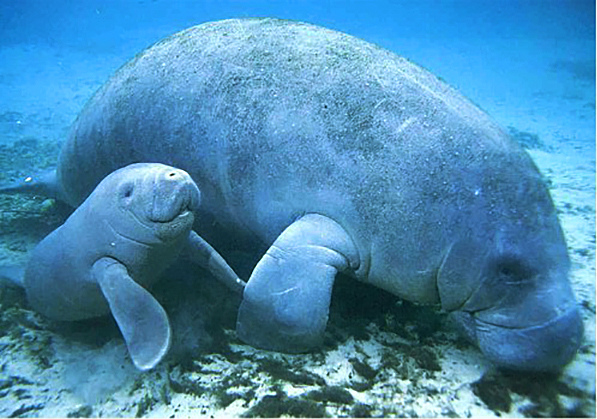Trichechus senegalensis
IUCN
LCBasic Information
Scientific classification
- name:Trichechus senegalensis
- Scientific Name:African manatee,African manatee, Seacow,Lamantin d'Afrique, Lamantin du Sénégal,Manatí de Senegal
- Outline:Carnivora
- Family:Sirenia Trichechidae Trichechus
Vital signs
- length:Up to 4.5 meters
- Weight:200-500 kg
- lifetime:About 30 years
Feature
They may be the origin of the mermaid myths of central and west Africa.
Distribution and Habitat
West African manatees are found along the coast and in rivers of western Africa, from the southern Senegal River to the Quanza River in Angola. West African manatees mainly inhabit shallow coastal waters and freshwater rivers (fresh or saltwater). They prefer shallow estuaries and swamps with abundant aquatic plants, and studies have shown that they avoid saltwater. Their distribution is limited by temperature, and they rarely appear in waters below 18 degrees Celsius.
Appearance
The West African manatee is similar in appearance to its close relative, the West Indian manatee, with a fusiform body, a broad back without a dorsal fin, and a small head. It is gray in color, with thick, hard, slightly rough skin and sparse body hair. Individuals living on the coast may have barnacles attached to them. The eyes are small and slightly protruding (unlike the West Indian manatee, which has deeper eyes), and there are no external pinnae. The snout is thicker and shorter than that of the West Indian manatee, probably to adapt to eating floating, emergent plants and plants growing in shallows. There are three to four vestigial toenails on the outer side of the forelimbs. It has only molars, which are constantly replaced.
The West African manatee is herbivorous, feeding on a variety of floating, semi-aquatic and emergent plants and shallow plants. It will also eat forest fruits that fall into the river and discarded cassava husks, and even invade rice fields. The West Af
Details
The West African manatee (Trichechus senegalensis, African manatee) is a species of the family Sirenia, Sirenia, and is found in western Africa. It has long been an important source of meat, fat, and folk remedy consumables for the indigenous people of the African coast.

The West African manatee may be the origin of the mermaid myth in Central and West Africa, known as "mami-wata". The ecology of the West African manatee is full of mystery, perhaps as a result of hunting pressure. Although hunting in various regions threatens its survival, it still maintains roughly its previous distribution range.
West African Manatees-Are-Endangered.html">manatees are descendants of sea eels found in coastal areas of South America during the Pliocene epoch. Although they tend to stay in fresh water, it is theorized that the species reached West Africa during the late Pliocene epoch through transoceanic currents. The emergence of West African Manatees-Are-Endangered.html">manatees is thought to be a result of these currents and the movement of species. The ancestors of West African Manatees-Are-Endangered.html">manatees inherited favorable migration and food traits. West African manatees are not confined to a certain area, nor do they have to rely heavily on just one ecosystem for support. This evolutionary diversity of West African manatees may be part of their key attributes for survival. Due to their ability to survive in salt water, they are more diverse than other manatees, although they do need access to fresh water for drinking.
On June 24, 2019, China's first female West African manatee was born in Zhuhai.
The population of the West African manatee is unknown, and reports indicate that it is still declining. Informal surveys by fishermen and local residents indicate that the densest populations are located in Senegal, Guinea-Bissau, Côte d'Ivoire, Cameroon and Gabon. The West African manatee is protected by law in all its habitats, although it is listed in Appendix II of the Convention on International Trade in Endangered Species of Wild Fauna and Flora, and is protected by local national laws in all countries where it exists. However, due to the high level of poverty in the region, effective protection has become very difficult. The meat and fat of the manatee are very valuable, and residents continue to hunt them with harpoons, traps, nets or hooks. In some areas, there are legal challenges that have made it ineffective. Fortunately, 15 countries and 3 non-governmental organizations have signed a "Manatee Conservation Action" to agree to work together to protect the manatee and small cetaceans in West Africa and the Micronesian Islands. They are also threatened by habitat destruction, including deforestation and damming of rivers, with hydroelectric turbines sometimes causing their deaths. Some countries, including Senegal, Guinea-Bissau, Côte d'Ivoire, Nigeria, Cameroon and Gabon, have established manatee sanctuaries. Manatees trapped in shallow swamps along the Senegal River have been rescued and returned to the main river.
The West African manatee is listed as Vulnerable (VU) on the 2015 IUCN Red List of Threatened Species, ver3.1[2]








